Life and Leisure
Illuminating history
By Guo Shuhan (China Daily)
Updated: 2010-08-13 12:47
 |
Large Medium Small |
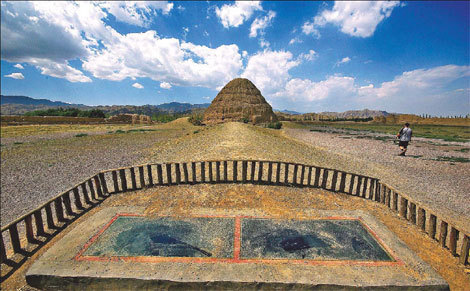
The Western Xia Tombs are a testament to a thriving culture about 1,000 years ago, at the foot of Helan Mountain near Yinchuan, Ningxia Hui autonomous region. Wu Qiming / China Foto Press |
Ningxia's desert sun shines light on the ancient secrets of its shadowy past. Guo Shuhan reports
The mysteries of the Western Xia Kingdom (1038-1227) come to light after sunset. Certainly, the sun's absence corresponds with tourists? rendering the otherwise bustling tableau desolate and tranquil - that is, ideal for careful examination and contemplation. Dusk's glow offers the most illuminating opportunity to wander the flagstone that spills into the mausoleum of the kingdom's first emperor, Li Yuanhao (1003-1048).
The tomb pocks the middle of Helan Mountain's eastern slope, 35 kilometers west of Yinchuan, capital of Ningxia Hui autonomous region. Today, the structure shines with the polish of ages, and gazing at the dilapidated shell of its former self enables one to reflect on how the winners not only get to write the history books but also burn those of their enemies.
Yuan Dynasty (1271-1368) conqueror Genghis Khan (1162-1227) practically wiped from the face of the earth any trace of the vanquished kingdom.
He obliterated its buildings and written records, effectively erasing it from the history books before it was written into them.
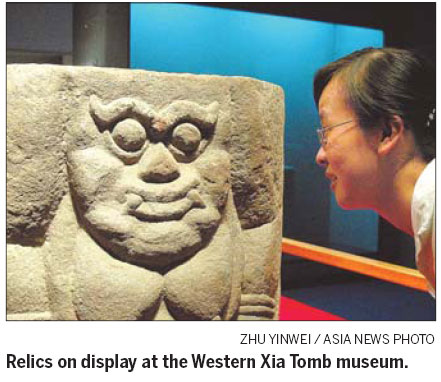
Surviving samples of the kingdom's unique scripts are displayed at the Western Xia Tomb museum. These specimens show a form of writing that is neater than its often-quadrangular mother script.
Scholars have deciphered only a few more than 1,000 of the tens thousands of Western Xia ideographs. Lay people can merely marvel at the pictographs' elaborate structures. The cross-era illiteracy has meant that the mausoleums of nine emperors and more than 140 tombs for princes, dukes and ministers are final resting places for not only the kingdom's nobility but also for its legacy.
In addition to allowing travelers to skip the tourist rush, paying an evening visit to the site also allows guests to dodge the intense glare of the daytime sun. The province is jammed between three scorched swaths of land - China's fourth largest desert, the Tengger, to the west, Badain Jaran Desert to the north and the Maowusu Sandy Area to the east.
While the overabundance of sunshine makes midday visits to the Western Xia Tomb too hot to handle, it also makes Shahu Lake, 42 km outside of Yinchuan, ideal for fun in the sun.
Visitors board the sightseeing boat from the area's watery north to its sandy south. Cable cars can be taken from the sand dunes' summit, but hotfooting it across the sand to finish the last leg on camelback enables visitors to better get in touch with the scenic spot's natural idiosyncrasies.
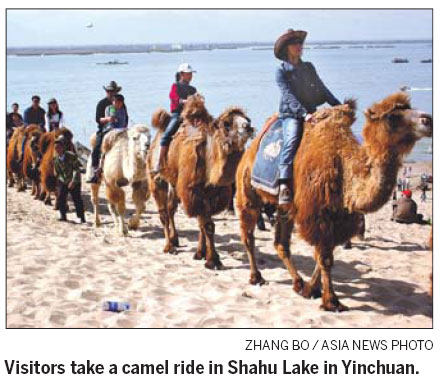
Those with a love of wildlife can also take to a tower or small boat to view the swans, white cranes and bitterns that flitter throughout this oasis.
While the lake area's ecological offerings are stunning, the manmade features of Helan Mountain hail from a different variety of magnificence.
The cliff markings here, which date from between 10,000 to 3,000 years ago, offer a picture of modern Ningxia's ancient lifestyles. These images depict the hunts, sacrificial ceremonies, wars and entertainments of the days of old.
The most remarkable archeological offering is a painting of the God of the Sun, etched into a bluff 40 meters above ground. The figure's eyes are formed by two concentric circles, and the lines that trace the god's eyelashes, hair and halo were drawn according to the principle of doublings, from 6 to 24 cm.
Visitors to the cliff paintings can rest at Mountain Cottage, a quaint eatery near the entrance. The farmhouse-style restaurant features an artificial stream spanned by a stone bridge. Local specialties include fried wild mushroom, "cold blossom of walnuts", and cold lujiaocai - an alga and mutton soup with sour radish. These are best washed down with homemade cherry and scorpion liquor, followed by a sobering dose of wild jujube tea.
Decades ago, Yinchuan was humorously conveyed using a caricaturized description: The only decent road, patrolled by a single policeman, was lined by two buildings - a postal and telecommunications compound, and a department store. The only occupants of a nearby park were two monkeys.
Today, the city has stepped up its modernization while drawing visitors with its ancient legacy.
It will soon get a new CBD area, planned to cover 282 hectares beside Yuehai Lake in central Jinfeng district. Once completed, its futuristic towers will rise from Yinchuan's historical foundations - much like the city's ever-evolving culture.
Five stars shine in Yinchuan
|
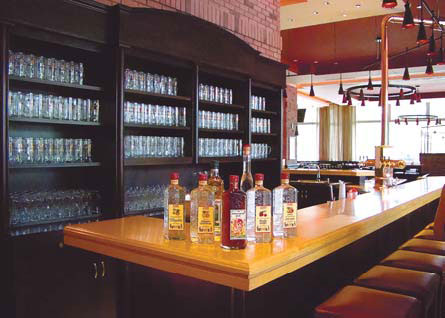 Kempinski Hotel Yinchuan offers authentic light and dark beer, made from wheat and rye grown in Germany. Guo Shuhan / China Daily |
Kempinski Hotel brought its traditional brand of luxury to Yinchuan, capital of Ningxia Hui autonomous region, in July.
The first international five-star hotel in the city, Kempinski unassumingly provides an attentive high-quality service and warm German welcome.
Here you can pamper yourself with the luxurious essential oil and flower spa treatments in the spa or sit back and relax in the Caf Berlin on the ground floor. The exquisite cuisine features local lamb, sushi, seasonal appetizers, pizza and pastas. And while you are here, don't pass up the opportunity to try the wine made with grapes from a local vineyard located at the foot of Helan Mountain.
Chef Kuchenbecker happily shared with me the origins of pretzels, which he calls the "German sunshine bread" because of the three "windows" that let sunlight onto the glazed surface. He recommended the Paulaner Brauhaus Brewery, only a few steps away if I wanted to enjoy authentic German beers.
Here the brew master from Germany offers fresh light and dark beer, made from wheat and rye grown in Germany. I preferred the sweet flavor of the dark, which I've not tasted anywhere else.
When it's time to retire for the night, the large soft bed and goose down quilt are enticements that are not long delayed.
If you go
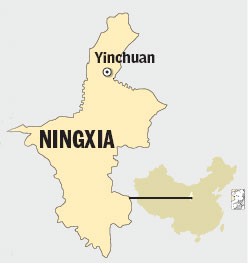
The plane ride from Beijing to Yinchuan is about two hours. Trains from Beijing Railway Station or Beijing West Station cost one-third the price of a flight but take nearly 10 times as much time. However the rail route does offer a chance to enjoy the constantly morphing scenery along the tracks.
Coaches from Yinchuan to Bayin pass the Western Xia Mausoleum, which takes about an hour to reach. It's more convenient to take the No 2 coach and then get a taxi from the stop at Western Xia Square.
Helan Mountain can be reached by taking a coach from Yinchuan's Nanmen Square to Zhenbeipu town and then hopping a cab to the mountain for about 15 yuan ($2).
A special coach travels between Nanmen Square and Shahu Lake. Tickets cost 10 yuan, and the ride is about an hour and a half.